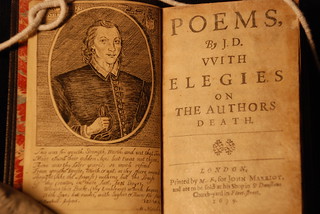
The University of Tulsa’s Department of Special Collections and University Archives recently acquired a posthumous publication of poet John Donne’s work. The book, first published in 1633, features a series of poems and sonnets that had never been published together, only is smaller miscellaneous forms.
“John Donne was an English poet, satirist, lawyer, and a cleric in the Church of England. He is considered the pre-eminent representative of the metaphysical poets. His works are noted for their strong, sensual style and include sonnets, love poetry, religious poems, Latin translations, epigrams, elegies, songs, satires and sermons” (poets.org). Donne was famous for his use of vibrant language and inventiveness in his works, especially when compared to his contemporaries.
After many years of writing and socializing in English courts Donne lost favor in the eyes of the English monarch, James I. The King admonished Donne for his publications Pseudo-Martyr and Ignatius His Conclave, in which the poet spoke against the Catholic Church. Under pressure from the monarchy Donne gave up writing to become an ordained minister of the Church of England, spending the remainder of his years as a revered and well known leader of the church.
Despite his ecclesiastical accomplishments, however, historians now remember Donne for his literary achievements, regarding him as the founder of metaphysical poets. Donne’s work enabled an age of publications that shocked and forced the reader to broaden their ideals and search for knowledge. “Donne reached beyond the rational and hierarchical structures of the seventeenth century with his exacting and ingenious conceits, advancing the exploratory spirit of his time” (poets.org).
To see this and many others works by John Donne and his contemporaries please visit Special Collections located on the fifth floor of McFarlin library, open Monday through Friday 8 am to 5 pm.
